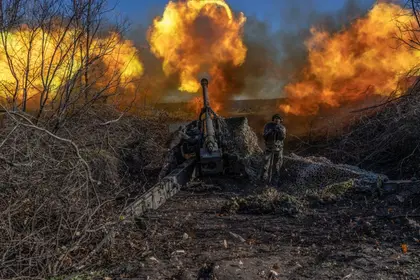As Kyiv’s national leadership counts down to the launch of a major offensive army gunners all along the line of contact have stepped up targeting of Russian artillery and claimed Armed Forces of Ukraine (AFU) kills of Moscow-operated howitzers and mortars over the last two weeks are up by almost exactly two-thirds, Kyiv Post analysis of AFU data showed.
During the two-week period Apr. 28 – May 11, according to official Russian equipment destruction claims published by Ukraine’s Army General Staff (AGS), Ukraine’s military by all means destroyed or otherwise put out of action 166 tube “artillery systems” – meaning mortars, howitzers and cannon operated by the Russian army.
- View the most up-to-date Ukraine news articles published today.
- Read the newest Ukraine news stories published today.
JOIN US ON TELEGRAM
Follow our coverage of the war on the @Kyivpost_official.
Over a parallel two-week period exactly one month earlier, from Mar. 29 – Apr. 11, the Ukrainian military claimed 108 systems destroyed. The category Russian army rocket artillery systems – including the widely-feared 122mm Grad and 300mm Smerch rocket launchers – by those numbers, saw a similar jump in claimed Ukrainian kills: from nine systems a month ago, to sixteen systems currently over a similar two-week period.
Retired Australian general Mick Ryan in an April interview said that maximum destruction of Russian artillery and artillery ammo dumps would be a logical objective for Ukraine’s high command prior to launching any major counteroffensive.

ISW Russian Offensive Campaign Assessment, January 21, 2025
An independent overview of Russian losses published by the Iceland-based analyst Ragnar Gudmundsson, using open-source data, registered a similar trend with Russian artillery losses spiking 21 percent over the last seven days, as compared to the previous seven days.
Some international analysts since Russia’s Feb. 2022 invasion have questioned the precision of Ukrainian claims of Russian military equipment kills, and suggested Kyiv might be inflating the numbers for propaganda purposes.
AGS spokesmen have said they believe the estimates to be highly accurate as all kill claims by troops, as a matter of army policy, must be documented by physical inspection on the ground or by reliable images, very frequently captured by civilian drones ubiquitously by front-line Ukrainian troops.
A typical engagement was recorded by a drone operated by the 36th Marine Brigade, an amphibious infantry formation operating in the Donbas sector, that observed a Russian two-man 82mm mortar team uncovering and opening fire from a residential courtyard in a village.
The officially redacted images show three howitzer shells striking the site directly, followed by an air burst and another shell leveling a house next to the mortar position. The video does not show Russian troops hit, but most military analysts would rate the mortar firing position as almost certainly destroyed, as did Kyiv Post analysts.
The AFU started receiving NATO-standard 155mm artillery systems in late April 2022, giving Ukrainian gunners the capacity to hit targets outside the range of Russian counterbattery fire.
The Poland-provided Krab self-propelled howitzer is so accurate it can hit a tank-sized target, without using a guided shell, at a range in excess of 30 kilometers, in five shots, a Krab commander identified as Artem told an AFU military reporter in an Apr. 27 report.
Ukrainian military Telegram channels in April complained frequently of spot artillery ammunition shortages, particularly around the battleground city Bakhmut, that caused the AFU to suffer heavy casualties because they had to hold back Russian attacks without proper artillery support.
In recent weeks, AFU and Russian army sources alike have reported Kyiv’s troops have far more to shoot with.
On May 10, in the Bakhmut sector, according to accounts from the 3rd Assault Brigade among others, AFU troops backed by substantial artillery ran a successful counterattack, advancing 2.6 kilometers and killing or putting to flight two companies from an elite Russian infantry brigade.
On May 5, the 35th Marine Brigade, a formation fighting to the north of Bakhmut, in an official statement said its gunners sometimes run four fire missions in a day – and in the unit record engagement the crew of a single 120 mm Nona self-propelled mortar system fired off 163 rounds in a single bombardment.
You can also highlight the text and press Ctrl + Enter










